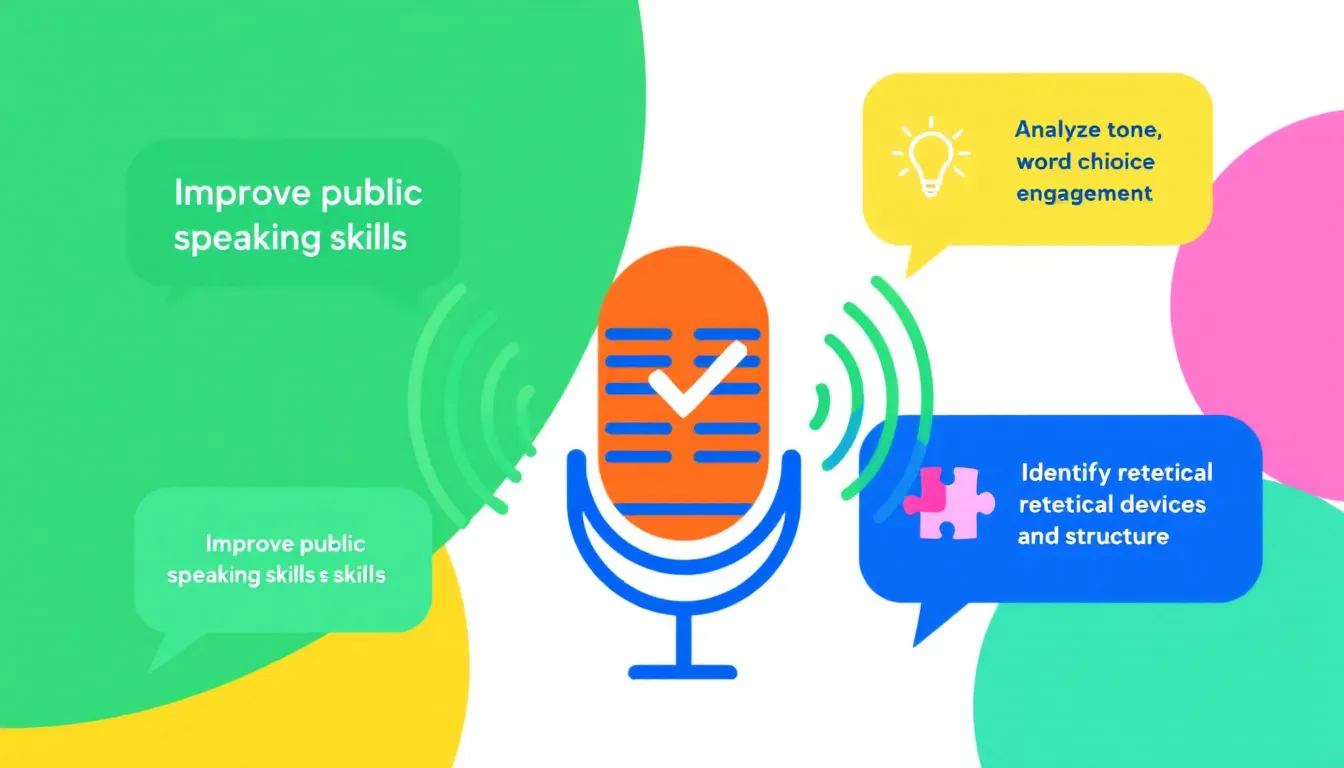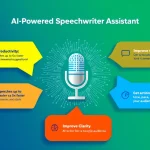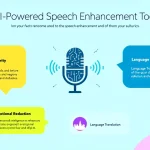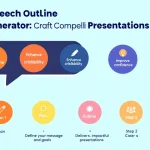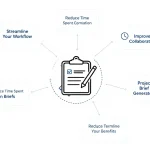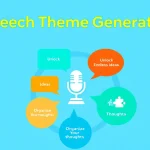Is this tool helpful?
How to Use the Speech Analysis Assistant Effectively
Our Speech Analysis Assistant is designed to help you refine and enhance your speeches, ensuring they resonate with your audience more effectively. Here’s a step-by-step guide on how to use this powerful tool:
- Input Your Speech Text: In the first field, paste the full text of your speech. For example, you could input a commencement address for a university graduation or a keynote speech for a business conference.
- Provide Context (Optional): In the “Speech Context” field, briefly describe the setting, audience, and purpose of your speech. For instance, you might enter “TED Talk on climate change for a general audience” or “Corporate presentation on quarterly results for shareholders.”
- Add Speaker Information (Optional): If relevant, provide details about the speaker in the “Speaker Info” field. This could be something like “Environmental scientist with 15 years of field experience” or “CEO of a Fortune 500 company.”
- Analyze Your Speech: Click the “Analyze Speech” button to submit your information for processing.
- Review the Analysis: Once processed, the tool will display a comprehensive analysis of your speech, including suggestions for improvement and detailed feedback.
- Copy and Apply Feedback: Use the “Copy to Clipboard” button to easily transfer the analysis to your preferred document editor for reference as you refine your speech.
By following these steps, you’ll be able to leverage the full potential of our Speech Analysis Assistant to create more impactful and engaging speeches.
Revolutionize Your Public Speaking with AI-Powered Speech Analysis
Public speaking is an art form that can make or break careers, inspire change, and leave lasting impressions. Our Speech Analysis Assistant is a cutting-edge tool designed to elevate your oratory skills to new heights. By harnessing the power of artificial intelligence and natural language processing, this innovative calculator provides in-depth analysis and tailored suggestions to enhance the clarity, engagement, and persuasiveness of your speeches.
Whether you’re a seasoned politician, a corporate executive, an aspiring motivational speaker, or a student preparing for a class presentation, our Speech Analysis Assistant is your secret weapon for crafting speeches that captivate, convince, and connect with your audience.
The Science Behind Effective Speeches
Effective speeches are more than just a collection of well-written words. They are carefully crafted compositions that balance several key elements:
- Tone: The overall mood and attitude conveyed through language and delivery
- Word Choice: The specific vocabulary used to express ideas and evoke emotions
- Style: The unique manner of expression that characterizes the speaker’s voice
- Structure: The logical organization and flow of ideas throughout the speech
- Rhetorical Devices: Techniques such as repetition, metaphor, and alliteration used to enhance impact
- Audience Engagement: Strategies to connect with and maintain the interest of listeners
Our Speech Analysis Assistant takes all these factors into account, providing a comprehensive evaluation that goes beyond simple grammar and style checks.
Benefits of Using the Speech Analysis Assistant
Incorporating our Speech Analysis Assistant into your speech preparation process offers numerous advantages:
1. Enhanced Clarity and Coherence
The tool meticulously analyzes your speech structure, identifying areas where your message may be unclear or your arguments could be strengthened. By highlighting these opportunities for improvement, you can ensure that your ideas flow logically and your main points are effectively communicated.
2. Improved Audience Engagement
Our AI-powered assistant evaluates your speech from the perspective of your intended audience. It provides suggestions on how to make your content more relatable, interesting, and memorable, helping you capture and maintain your listeners’ attention throughout your presentation.
3. Refined Tone and Style
The tool assesses the overall tone of your speech and offers recommendations to align it more closely with your intended message and audience expectations. Whether you’re aiming for an inspirational, authoritative, or empathetic tone, the assistant helps you fine-tune your language to achieve the desired effect.
4. Expanded Vocabulary and Word Choice
By analyzing your word choice, the Speech Analysis Assistant can suggest more impactful alternatives or highlight overused terms. This feature helps you diversify your language, making your speech more engaging and sophisticated.
5. Personalized Feedback
Unlike generic writing tools, our assistant takes into account the specific context of your speech, including the audience, purpose, and speaker information. This allows for highly tailored suggestions that consider the unique aspects of your presentation scenario.
6. Time-Saving Efficiency
Instead of spending hours agonizing over every word and phrase, you can quickly get expert-level feedback on your entire speech. This efficiency allows you to focus more time on rehearsing and perfecting your delivery.
7. Continuous Improvement
By consistently using the Speech Analysis Assistant, you’ll develop a better understanding of effective speech-writing techniques. Over time, this will naturally enhance your ability to craft compelling speeches even without the tool’s assistance.
Addressing User Needs and Solving Specific Problems
Our Speech Analysis Assistant is designed to address a wide range of challenges faced by public speakers at all levels of experience. Let’s explore how it tackles some common issues:
Problem: Lack of Coherence
Many speakers struggle with organizing their thoughts into a cohesive narrative. The Speech Analysis Assistant evaluates the structure of your speech, identifying areas where the flow of ideas could be improved. It might suggest rearranging paragraphs, adding transitional phrases, or clarifying the relationship between different points to create a more logical progression.
Example:
Input Speech Excerpt:
“Global warming is a serious issue. We need to act now. Polar bears are losing their habitats. Renewable energy is important. The Earth is getting warmer every year.”
Analysis Feedback:
“Consider restructuring your points for better coherence. Start with the broader issue of global warming, then move to specific effects like habitat loss, and finally discuss solutions such as renewable energy. A revised structure could be:1. Introduce global warming and its urgency 2. Discuss the Earth’s increasing temperature 3. Provide examples of impacts (e.g., polar bear habitat loss) 4. Present solutions like renewable energy 5. Call to action for immediate stepsThis structure creates a more logical flow from problem to solution.”
Problem: Inappropriate Tone
Matching the tone of your speech to your audience and purpose is crucial for effective communication. The Speech Analysis Assistant evaluates the overall tone of your speech and suggests adjustments to better align with your intended message and audience expectations.
Example:
Input Speech Context: “Motivational speech for high school graduates”
Input Speech Excerpt:
“As you embark on this new phase of your life, it is imperative that you give due consideration to the multifaceted challenges that await you in the professional sphere. The acquisition of marketable skills and the cultivation of a robust professional network are paramount to achieving success in today’s highly competitive job market.”
Analysis Feedback:
“The current tone may be too formal and academic for a motivational speech to high school graduates. Consider using more conversational and inspiring language to better connect with your young audience. A revised version could be:‘As you start this exciting new chapter of your life, get ready for some amazing challenges and opportunities ahead! Focus on building skills that’ll make you stand out in the job market, and don’t forget to connect with people who can help you along the way. In today’s competitive world, it’s not just what you know, but who you know that can make a big difference.'”
Problem: Lack of Persuasive Elements
For speeches aimed at convincing or motivating an audience, incorporating persuasive techniques is essential. The Speech Analysis Assistant identifies opportunities to enhance the persuasive power of your speech by suggesting rhetorical devices, emotional appeals, or stronger arguments.
Example:
Input Speech Excerpt:
“Our company should invest in artificial intelligence. It can help us improve efficiency and reduce costs. Many other companies are already using AI successfully.”
Analysis Feedback:
“To make your argument more persuasive, consider incorporating the following elements:1. Use a rhetorical question to engage the audience: ‘Can we afford to fall behind in the AI revolution?’ 2. Provide specific examples or statistics: ‘Companies that have implemented AI have seen an average 30% increase in productivity.’ 3. Address potential concerns: ‘While there may be initial costs, the long-term benefits far outweigh the investment.’ 4. Use emotive language to create urgency: ‘The AI train is leaving the station – we need to be on board or risk being left in the dust.’ 5. End with a strong call to action: ‘The time to embrace AI is now. Let’s lead the charge in our industry and secure our future success.'”
Practical Applications and Use Cases
The Speech Analysis Assistant is a versatile tool that can benefit speakers across various domains and scenarios. Here are some practical applications:
1. Political Speeches
Politicians and campaign managers can use the tool to craft speeches that resonate with their constituents. The assistant can help balance policy details with emotional appeals, ensure consistent messaging across different audiences, and identify opportunities to incorporate local issues or concerns.
Use Case: Crafting a Campaign Launch Speech
A political candidate could input their draft campaign launch speech into the Speech Analysis Assistant. The tool would analyze the content for key campaign themes, evaluate the balance of personal story-telling and policy proposals, and suggest ways to make the speech more memorable and quotable for media coverage.
2. Corporate Presentations
Business leaders can leverage the tool to prepare for important presentations, such as quarterly earnings calls, product launches, or company-wide addresses. The assistant can help strike the right tone between confidence and realism, ensure technical information is presented clearly, and suggest ways to address potential investor or employee concerns.
Use Case: Annual Shareholder Meeting Address
A CEO preparing for an annual shareholder meeting could use the Speech Analysis Assistant to review their address. The tool would assess the balance of past performance review and future outlook, suggest ways to explain complex financial data in more accessible terms, and identify opportunities to reinforce the company’s long-term vision and strategy.
3. Academic Lectures
Educators and researchers can utilize the tool to enhance their teaching and presentation skills. The assistant can help break down complex topics into more digestible segments, suggest engaging examples or analogies, and ensure the content is pitched at the appropriate level for the intended audience.
Use Case: Introductory Lecture for a New Course
A professor could input the script for their first lecture of a new course into the Speech Analysis Assistant. The tool would evaluate the balance of course overview, learning objectives, and introductory content. It might suggest ways to make the material more engaging for new students, such as incorporating relevant current events or interactive elements.
4. Motivational Speaking
Professional speakers and life coaches can use the tool to craft inspiring and impactful presentations. The assistant can help identify powerful storytelling opportunities, suggest ways to build emotional connections with the audience, and ensure the speech has a clear and actionable takeaway.
Use Case: TED Talk Preparation
A speaker preparing for a TED Talk could use the Speech Analysis Assistant to refine their presentation. The tool would analyze the speech for the hallmark elements of successful TED Talks, such as a strong opening hook, personal anecdotes, and a novel idea or perspective. It might suggest ways to simplify complex concepts, incorporate more vivid imagery, or end with a powerful call to action.
5. Wedding Toasts and Special Occasion Speeches
Even for personal speeches, the Speech Analysis Assistant can be a valuable tool. It can help balance humor and sentiment, ensure the content is appropriate for a diverse audience, and suggest ways to make the speech more memorable and heartfelt.
Use Case: Best Man Speech
A best man nervously preparing his wedding toast could input his draft into the Speech Analysis Assistant. The tool would evaluate the balance of humor and sincerity, suggest ways to structure the speech for maximum impact, and identify any potentially inappropriate content. It might also recommend ways to incorporate personal stories that highlight the bond between the speaker and the groom.
Frequently Asked Questions (FAQ)
Q1: How long should my speech input be for optimal analysis?
A1: The Speech Analysis Assistant can handle speeches of various lengths, from short 5-minute presentations to longer keynote addresses. For the most comprehensive analysis, we recommend inputting your entire speech. However, if you’re working on a particularly long speech, you may find it helpful to analyze it in sections.
Q2: Can the tool help me with speech delivery techniques?
A2: While the Speech Analysis Assistant primarily focuses on content and structure, it can provide some insights that may improve delivery. For example, it might suggest places where pauses could be effective or identify sections that might benefit from a change in tone or pace.
Q3: Is the Speech Analysis Assistant suitable for non-native English speakers?
A3: Absolutely! The tool can be particularly helpful for non-native speakers by identifying potential language issues and suggesting more natural phrasing. It can also help ensure that the vocabulary and idioms used are appropriate for the intended audience.
Q4: How often should I use the Speech Analysis Assistant during my speech preparation process?
A4: We recommend using the tool at various stages of your preparation. You might start with an initial analysis of your first draft to get broad structural and content suggestions. Then, as you refine your speech, you can use the tool for more detailed feedback on specific sections or to fine-tune your language and style.
Q5: Can the Speech Analysis Assistant help me tailor my speech for different audiences?
A5: Yes, this is one of the tool’s strengths. By providing context about your audience in the optional fields, you allow the assistant to offer more tailored suggestions. For example, it might recommend different language or examples for a speech to be delivered to high school students versus one for a professional conference.
Q6: Will using the Speech Analysis Assistant make my speech sound robotic or inauthentic?
A6: Not at all. The tool is designed to enhance your unique voice, not replace it. It provides suggestions and insights, but the final decisions on content and style remain yours. The goal is to help you communicate your ideas more effectively while maintaining your authentic voice.
Q7: Can the Speech Analysis Assistant help with speeches in languages other than English?
A7: Currently, the tool is optimized for English language speeches. However, we are continuously working on expanding our language capabilities. Stay tuned for updates on additional language support.
Q8: How does the Speech Analysis Assistant handle technical or industry-specific jargon?
A8: The tool has a broad knowledge base that includes many technical and industry-specific terms. However, it’s always a good idea to provide context about your audience in the optional fields. This helps the assistant determine whether technical language is appropriate or if it should suggest more accessible alternatives.
Q9: Can the Speech Analysis Assistant help me incorporate storytelling techniques into my speech?
A9: Absolutely! The tool can identify opportunities for storytelling and suggest ways to incorporate narrative elements effectively. It might recommend places to add personal anecdotes, suggest how to structure a story for maximum impact, or offer tips on using descriptive language to make your stories more vivid and engaging.
Q10: How does the Speech Analysis Assistant stay updated on current events and trends?
A10: Our team regularly updates the tool’s knowledge base to ensure it stays current with world events, popular culture, and emerging trends. However, for very recent or niche topics, it’s always a good idea to double-check any specific references or examples suggested by the tool.
By leveraging the power of our Speech Analysis Assistant and applying the insights it provides, you can transform your speeches from good to great, leaving lasting impressions on your audiences and achieving your communication goals with confidence and clarity.
Important Disclaimer
The calculations, results, and content provided by our tools are not guaranteed to be accurate, complete, or reliable. Users are responsible for verifying and interpreting the results. Our content and tools may contain errors, biases, or inconsistencies. We reserve the right to save inputs and outputs from our tools for the purposes of error debugging, bias identification, and performance improvement. External companies providing AI models used in our tools may also save and process data in accordance with their own policies. By using our tools, you consent to this data collection and processing. We reserve the right to limit the usage of our tools based on current usability factors. By using our tools, you acknowledge that you have read, understood, and agreed to this disclaimer. You accept the inherent risks and limitations associated with the use of our tools and services.
